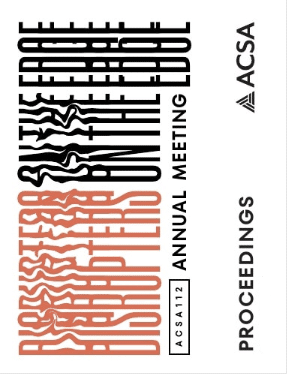Author(s): Jonathan K. Stevens
Equitable access to deeper learning1 is essential to the discipline of architecture. But what happens when opportunities are stifled in an evolving architectural education? This qualitative research reviews the role a theoretical process plays in empowering upper-division Historically Black College and University (HBCU) architecture students to engage in mate-rial-based architectural learning to help reduce impostor syndrome in a post-pandemic digital culture. HBCU students, like 84 percent of university students across the United States2, were part of the ‘Covid-19 remote learning’ generation. During and post completely remote learning, several students – approximately 50 percent surveyed during this course3 – missed their opportunity to access the experiences and knowledge that come with hands-on material exploration. By bypassing their opportunities to engage with analog materials, many students lacked the confidence to discuss architectural materiality, which could ultimately lead them to prolonged intellectual insecurities. So, as educators and practitioners, how can our pedagogies provide better access to knowledge and overcome the root causes of impostor syndrome? Through using inclusive theories and equitable experiences in a transformative way, I believe we can better adapt academic tools to reinforce a sense of belonging while continuing to promote diversity in our communities and environments. To empower through access and opportunities, the process below describes how a group of eleven students gained direct experience through a series of prompts used to transform their knowledge into over 150 unique physical objects. The required course began with presentations and group conversations reviewing Donald Judd and Michael Benedikt’s theories and exploring the psychological significance embedded in tangible objects. Written commentaries and in-class dialogue became a venue to critically analyze and validate the connections between architectural space and materiality through the lens of time, value, and reality. To further instill self-assurance, the students engaged in the physical material exploration of new and found building materials. Each student used their experiences to create individually unique wood, cast masonry, metal, and composite ‘Objects’ (2.5”x2.5”x10”) that emphasize their design process. A ‘process,’ as described by Gail Peter Borden4, provided a physical outlet for personal growth. Several students went from only using materials in a digital environment3 to demonstrating fabrication skills beyond basic cutting, carving, casting, and welding. During the exploration process, many students expressed their greater appreciation for the mental and physical difficulty of material manipulation.3 And, similar to Enzo Mari’s thoughts on ‘understanding,’5 this deeper learning empowered the students to develop transferable knowledge6 and confidently convey their design intentions at the intersections between critical analysis and the physical manifestations of their ideas. Ultimately, over 85 percent of the students surveyed expressed that using physical material expanded their self-assurance, and they foresee using their expanded observation and making skills in the academic and professional architecture environment.7 At the completion of the course, the students understood that access to opportunity and essential knowledge facilitates our ability to communicate and emphasize architectural experiences. And, through the process of discovering the transferable knowledge inherent in analog material implementation, we are empowered to reflect ourselves into equitable built environments.
https://doi.org/10.35483/ACSA.AM.112.74
Volume Editors
Germane Barnes & Blair Satterfield
ISBN
978-1-944214-45-6

 Study Architecture
Study Architecture  ProPEL
ProPEL 
